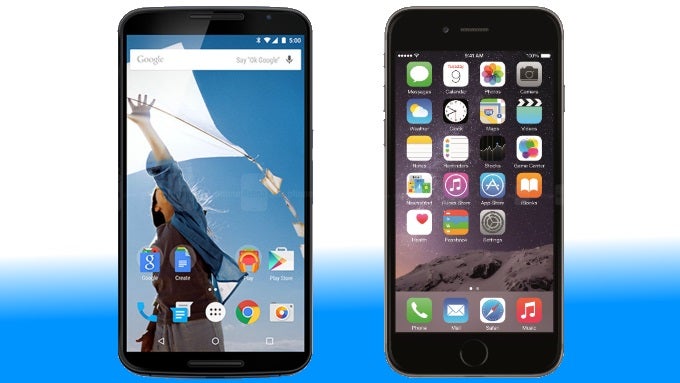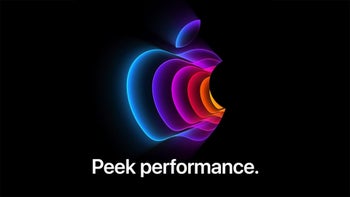Google Nexus 6 vs iPhone 6 Plus: in-depth specs comparison

Introduction
After weeks of teasing and hesitation, Google and Motorola finally unleashed the Nexus 6. The first Nexus phablet is a total race-car of a phone - it's got aggressive looks, gobs of raw power under the hood, and a huge 5.9-inch QHD display. It also runs Android 5.0 Lollipop, the latest version of the world's most popular operating system. All in all, the Nexus 6 is a serious opponent of the Apple iPhone 6 Plus, which is a phablet designed with a similar mentality - to showcase the latest version of iOS 8 - but represents an entirely different philosophy and approach. Obviously, the Nexus 6 is as Google as it can be, while the iPhone 6 is Apple all the way! Let's see how the two compare in terms of design, specs, battery life, and pricing. It will be one of the hottest duels for phablet shoppers this year!
Design
Unapologetically huge!
The Nexus 6 and iPhone 6 Plus have exactly three things in common. They are sixth-generation devices. They are the first Google and Apple phablets. And they are both unapologetically huge. Otherwise, they are as different as they can be, especially in design - the first is a plastic phablet with an astonishing metal frame, and the second is precision-carved from a big ol' aluminium block. And while we're at it, please drop the bend jokes. They were fun for a while, but the iPhone doesn't bend in your jeans unless you do it on purpose. Plain and simple! In addition, the Nexus 6 has its volume and power buttons on the right, with no Home button at all. Meanwhile, the iPhone 6 Plus rocks a power button to the left, volume buttons on the right, and a fingerprint-sensing Home button on the bottom. Both phabs won't let you remove their back panels to swap the battery. Sometimes design has to win over function.
How do the two giants size up against each other? With the presence of a bigger display (5.9-inches vs 5.5 inches) and dual front-facing speakers, it's immediately obvious that the Nexus 6 is larger at 6.27 x 3.27 x 0.40 inches (159.26 x 82.98 x 10.06 mm), and heavier at 6.49 oz (184 g). The iPhone 6 Plus is smaller, but not any more compact at 6.22 x 3.06 x 0.28 inches (158.1 x 77.8 x 7.1 mm), 6.07 oz (172 g). Unless you have hands like big Shaq, both phablets are largely unusable with a single appendage, although Apple's one-handed usage mode alleviates the problem to a degree.
Display
Large screens to keep your eyes wide open.
Although both phones are designed for maximalists, the Nexus 6 has a truly king-sized display. It's a 5.9-inch QHD AMOLED panel whose size, resolution (2560 x 1440) and pixel density (493 ppi) trump the iPhone 6 Plus' LCD screen's 5.5-inch diagonal, 1080p resolution, and 401ppi pixel density. Still, it's one thing to compare displays on paper, and a whole another thing to precisely measure both and see them in live action. So we'll reserve our final judgement for the time when we've had the opportunity to put the Nexus 6 through our display test. But we have to say, our expectations are high!
Interface and functionality
Customization and openness versus conservatism and intuitiveness.
In the fight to claim market share from Apple's iOS 8, Google brought in the absolute latest version of Android in a pure, unmodified form. In version 5.0 Lollipop, Android finally boasts a cohesive, strict design language like that of iOS. It's called Material Design and it's focused on natural movement animations alongside a paper magazine-like design approach. The operating system is focused on customization, multi-platform integration, and whatever you can think about, really. Android does it all! iOS 8 is a sleeker, more conservative and intuitive operating system which makes the best & worst of Apple's "walled garden", white gloves approach to developing it. It's notable for punchy colors, translucency, and the incredible fluidness that only an OS designed for very specific hardware can obtain. However, it's safe to say that at this point, the differences between the two are related to design and customization, with other features being mostly on par. While you're at it, be sure to check out our early comparison of Android Lollipop versus iOS 8 for a comprehensive look at the two dominating mobile operating systems.

Processor and memory
Welcome to the powerhouse!
The Nexus 6 and iPhone 6 Plus benefit from the inclusion of the latest and fastest commercially available technologies. However, Google-Motorola and Apple's approaches are quite different. The former opted for a huge, very high resolution display, stereo speakers, a quad-core Snapdragon 805 32-bit processor clocked at a whopping 2.7GHz, a fast Adreno 420 graphics unit, and 3GB of RAM. Google and Motorola wanted the best to showcase Android 5.0 to its fullest extent. Apple, meanwhile, stuck to its conservative approach of making wonders happen with hardware that's both cutting-edge and abysmal. The iPhone 6 Plus has a dual-core 64-bit processor clocked at 1.4GHz, a pretty powerful PowerVR GX6650 GPU, and an unimpressive 1GB of RAM. Yet, the iPhone 6 Plus is equally capable of running graphics-intensive games and a multitude of apps. In other words, performance is never an issue, until one decides to upgrade to the latest iOS version after two years and the hardware starts to feel long in the tooth.
Camera
Fantastic camera-phablets!
The Nexus 6 sounds like a fantastic camera-phone. It has a 13-megapixel rear autofocus cam with optical image stabilization, dual LED flash, and F2.0 aperture size. It is able to record video at up to 4K (3840x2160) resolution at 30fps, and 1080p video at 60 fps. The front camera is a modest 2MP unit which should provide satisfactory selfies and you will look lively enough in video chats.
Apple's aforementioned conservatism carries over in the iPhone 6 Plus's camera, which is very much the same as last year's. It's an 8MP main camera with dual LED flash, F.2. aperture, and a back-illuminated sensor along with phase detection autofocus and optical image stabilization. It is able to record video at up to 1080p 60 fps. The front camera is a 1.2MP unit which is not exactly impressive, but it does what it has to do.
Battery life
How fast can you charge a battery?
Being a bigger phablet, the Nexus 6 comes with a generous 3220mAh battery. It also feature a very advanced rapid charging technology that is said to charge the battery to a state good for 6 hours of use in just 15 minutes. We'll have to see it with our eyes to believe this! Meanwhile, Apple's iPhone 6 Plus has an adequate 2915mAh battery which lasts for 6 hours in 32 minutes of on-screen usage as measured in our battery test.
Conclusion
The Nexus 6 is a specs enthusiast's dream phone, while the iPhone 6 Plus is for those that want an even bigger iPhone 6.
With hardware considered, let's look at these bad boys' pricing. So far, we've heard that the Nexus 6 will go on sale for $649 unlocked. It will come to the four major US carriers in November, although they haven't disclosed their pricing yet. Pre-orders will begin October 29th, with shipping reportedly scheduled to start on November 12.
As for the iPhone 6 Plus, it is available for $299 (16GB), $399 (32GB), and $499 (128GB) on the four major US carriers, and $749 (16GB), $849 (64GB), and $949 (128GB) unlocked.
Thus, with the Nexus 6, you get unquestionably more bang for your buck. The question is whether you really need it. That's up to you to decide. Both phablets are very compelling and have their own distinct advantages. But they are ultimately designed to satisfy very different customers. The Nexus 6 is a specs enthusiast's dream phone, perhaps to an overkill extent, while the iPhone 6 Plus is for those that want an even bigger iPhone 6. What's for certain is that you won't regret buying any of the two, unless it turns out there's some major unforeseen error with the Nexus 6. So far, Nexus phone have had a pretty solid history, so we doubt that will be the case!
Follow us on Google News









![A new Android bug is making it impossible to install new apps. Are you affected? [UPDATE]](https://m-cdn.phonearena.com/images/article/176703-wide-two_350/A-new-Android-bug-is-making-it-impossible-to-install-new-apps.-Are-you-affected-UPDATE.webp)



Things that are NOT allowed:
To help keep our community safe and free from spam, we apply temporary limits to newly created accounts: